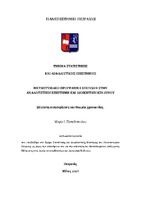Βέλτιστη αντασφάλιση και θεωρία χρεοκοπίας
Optimal reinsurance and ruin theory

Master Thesis
Συγγραφέας
Παπαδοπούλου, Μαρία Ι.
Ημερομηνία
2017-05Επιβλέπων
Χατζηκωνσταντινίδης, ΕυστάθιοςΠροβολή/
Λέξεις κλειδιά
Θεωρία χρεοκοπίας ; Θεωρία κινδύνου ; Κλασσικό μοντέλο θεωρίας κινδύνων ; Αντασφάλιση ; Συντελεστής προσαρμογής ; Οικονομετρικά υποδείγματαΠερίληψη
Η θεωρία των κινδύνων μελετά όλες τις πτυχές ενός χαρτοφυλακίου ασφάλισης ζημιών. Σε αυτή την ευρεία περιοχή, η θεωρία της χρεοκοπίας επικεντρώνεται στη μακροχρόνια χρεοκοπία μιας ασφαλιστικής εταιρείας με τέτοιου είδους χαρτοφυλάκιο. Ένα άλλο μέρος της θεωρίας των κινδύνων, ασχολείται με τη διαδικασία αντασφάλισης, κατά την οποία μια ασφαλιστική εταιρεία μεταβιβάζει μέρος ή το σύνολο του κινδύνου σε μία άλλη ασφαλιστική εταιρεία, η οποία ονομάζεται αντασφαλίστρια εταιρεία. Η θεωρία της αντασφάλισης και της χρεοκοπίας είναι μέρη της θεωρίας των κινδύνων, τα οποία συνδέονται στενά.
Η θεωρία της χρεοκοπίας έχει μελετηθεί πάνω από έναν αιώνα. Στις αρχές του 2θου αιώνα, οι Σουηδοί αναλογιστές Lundberg και CRAMER δημιούργησαν τα θεμελιώδη στοιχεία του κλασικού μοντέλου κινδύνου σε συνεχή χρόνο. Αυτό το μοντέλο επεκτάθηκε ευρέως κατά την διάρκεια του περασμένου αιώνα. Ο Andersen βελτίωσε εις βάθος το μοντέλο των CRAMER - LUNDBERG, το 1957, όπου θεωρούσε ότι η διαδικασία άφιξης των απαιτήσεων εκφράζεται μέσω μιας ανανεωτικής διαδικασίας. Πρόσφατα, οι GERBER & SHIU (1998) επανεξέτασαν τη θεωρία της χρεοκοπίας με την αναμενόμενη προεξοφλητική συνάρτησης ποινής. Η λεγόμενη συνάρτηση GERBER - SHIU επιτρέπει την ανάλυση μέτρων χρεοκοπίας, όπως είναι η πιθανότητα χρεοκοπίας, η συμπεριφορά του πλεονάσματος σε χρεοκοπία και άλλα. Στην παρούσα εργασία, επομένως, θα αναλυθεί το κλασικό μοντέλο της θεωρίας κινδύνου και η έννοια της αντασφάλισης, ενώ στην συνέχεια στα κεφάλαια 3 και 4 θα πραγματοποιηθεί μία ενδελεχής μελέτη για τον συντελεστή προσαρμογής R με αντασφάλιση. Κατόπιν, στο 5o κεφάλαιο γίνεται λόγος για την συνάρτηση GERBER - SHIU με αναλογική αντασφάλιση.


